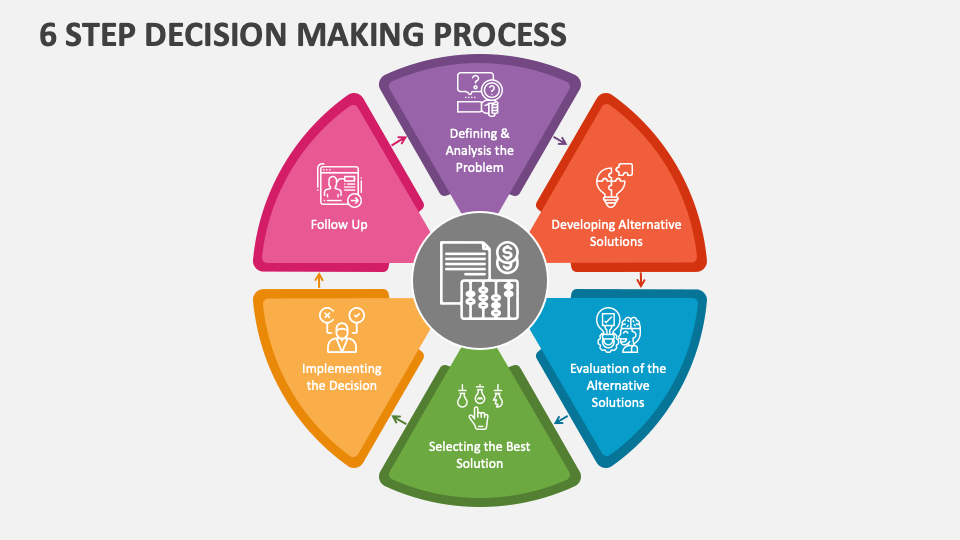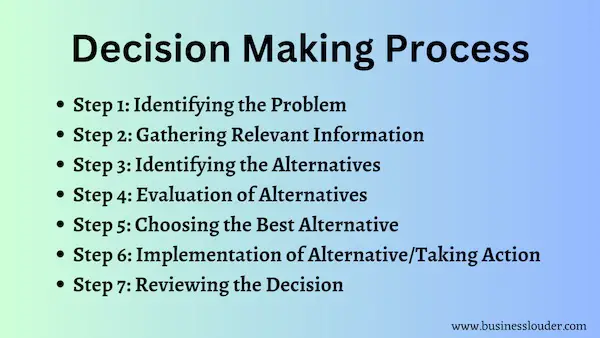The Decision Making Process: 6 Key Steps

Making decisions is an integral part of our daily lives, from choosing what to wear in the morning to deciding on life-changing career paths. The ability to make effective decisions is a valuable skill that can greatly impact our personal and professional success. In this article, we delve into the intricate world of decision making, exploring the six key steps that contribute to informed and strategic choices. Through a combination of real-world examples and expert insights, we aim to provide a comprehensive guide to mastering the art of decision making.
Understanding the Decision-Making Process

The decision-making process is a structured approach to evaluating and selecting the best course of action from various options. It involves a series of steps that help individuals and organizations navigate complex situations and arrive at well-informed decisions. By breaking down the process into manageable stages, individuals can enhance their decision-making abilities and increase the likelihood of positive outcomes.
Each step of the decision-making process plays a crucial role in shaping the final choice. Let's explore these steps in detail and understand how they contribute to effective decision making.
Step 1: Define the Problem

The first step in the decision-making process is to clearly define the problem or opportunity at hand. This step is often overlooked, but it is essential for setting the right direction and scope for the decision. A well-defined problem statement provides a solid foundation for the subsequent steps.
Consider the case of a business owner, Emma, who is facing a decision about expanding her online retail store. By clearly defining the problem, she can focus on specific aspects such as whether to introduce new product lines, improve the existing ones, or explore new marketing strategies. Defining the problem helps Emma narrow down her options and align her decision with her business goals.
Tips for Problem Definition
- Be specific: Avoid vague or broad problem statements. Specify the exact nature of the issue or opportunity.
- Consider the context: Understand the broader context in which the problem exists. This includes factors like market trends, competitor actions, and internal capabilities.
- Define the desired outcome: Clearly articulate what success looks like for this decision. This will guide the evaluation of options in later steps.
Step 2: Gather Information
Once the problem is defined, the next step is to gather relevant information to support the decision-making process. This step involves researching, analyzing data, and seeking expert opinions to gain a comprehensive understanding of the problem and potential solutions.
For instance, Emma, our business owner, might gather information on market demand for her product categories, analyze customer feedback, and consult with industry experts to understand the latest trends. This information gathering phase helps her identify the most promising avenues for expansion.
Strategies for Effective Information Gathering
- Define information needs: Identify the specific types of data and insights required to make an informed decision. This could include market research, financial analysis, or technical assessments.
- Utilize diverse sources: Rely on multiple sources of information to ensure a well-rounded perspective. This could involve internal data, external market research, and expert consultations.
- Prioritize reliability: Evaluate the credibility and reliability of the information sources. Ensure that the data and insights are based on sound methodologies and reputable sources.
Step 3: Identify and Evaluate Options
With a clear problem definition and comprehensive information in hand, the next step is to identify and evaluate potential options. This involves brainstorming and generating a range of alternatives, followed by a critical evaluation of each option’s feasibility, risks, and potential outcomes.
In Emma's case, she might identify options such as expanding into international markets, launching a subscription-based model, or investing in innovative product development. By evaluating these options based on factors like market potential, financial feasibility, and operational risks, she can prioritize the most promising strategies.
Guidelines for Option Evaluation
- Generate multiple options: Encourage creativity and critical thinking to generate a diverse range of alternatives. This ensures a comprehensive exploration of possibilities.
- Use structured evaluation criteria: Develop a set of evaluation criteria that aligns with the defined problem and desired outcomes. These criteria could include financial viability, market impact, operational feasibility, and strategic alignment.
- Consider short-term and long-term impacts: Evaluate the potential short-term benefits and long-term implications of each option. This helps assess the sustainability and longevity of the chosen strategy.
Step 4: Make the Decision

After evaluating the options, it’s time to make the decision. This step involves selecting the most suitable option based on the evaluation criteria and the desired outcomes. It requires a balance between analytical thinking and intuition, considering both the quantitative and qualitative aspects of the decision.
For Emma, the decision might be to focus on international expansion, backed by market research indicating strong demand for her products overseas. By weighing the risks and potential rewards, she can make an informed choice that aligns with her business objectives.
Tips for Decision Making
- Trust your judgment: While data and analysis are crucial, trust your instincts and consider your unique insights and experiences. Intuition can provide valuable guidance in decision making.
- Consider the consequences: Think through the potential consequences of each option, both positive and negative. This helps mitigate risks and ensure a well-rounded decision.
- Seek feedback: Engage with trusted advisors or colleagues to gain fresh perspectives and validate your decision. External feedback can provide valuable insights and help refine your choice.
Step 5: Implement and Monitor
Once the decision is made, the next step is to implement the chosen strategy effectively. This involves developing an action plan, allocating resources, and executing the decision with precision.
In Emma's case, the implementation phase might involve creating a detailed plan for international expansion, including market entry strategies, supply chain management, and marketing campaigns. Effective implementation requires careful planning and timely execution.
Keys to Successful Implementation
- Develop a comprehensive plan: Create a step-by-step plan that outlines the actions, timelines, and responsibilities required for successful implementation. This plan should be realistic and achievable.
- Allocate resources wisely: Ensure that the necessary resources, such as budget, personnel, and technology, are allocated to support the decision. Efficient resource allocation is crucial for successful implementation.
- Monitor and adjust: Regularly monitor the progress and outcomes of the implemented decision. Be prepared to make adjustments as needed to address challenges or seize new opportunities.
Step 6: Learn and Adapt
The final step in the decision-making process is to reflect on the outcomes and learn from the experience. This step involves evaluating the success or challenges of the decision and using those insights to improve future decision-making processes.
After implementing the international expansion strategy, Emma might analyze the results, identify areas for improvement, and refine her decision-making approach for future initiatives. Learning from past decisions is a crucial aspect of continuous improvement.
Strategies for Continuous Improvement
- Conduct post-decision evaluations: Regularly assess the outcomes and impacts of your decisions. Identify what worked well and what could be improved.
- Document lessons learned: Maintain a record of the lessons learned from each decision-making process. This knowledge can be valuable for future decisions and can help refine your approach.
- Embrace a culture of learning: Encourage a mindset of continuous learning and improvement within your organization or team. Embrace failures as opportunities for growth and innovation.
The Impact of Effective Decision Making
Mastering the decision-making process has far-reaching implications for individuals and organizations. Effective decision making leads to better outcomes, increased efficiency, and enhanced problem-solving capabilities. It empowers individuals to navigate complex situations with confidence and make strategic choices that drive success.
By following the six key steps outlined in this article, individuals can approach decision making with a structured and informed mindset. Whether it's personal or professional decisions, this process provides a roadmap for making choices that align with goals, values, and aspirations.
Remember, decision making is a skill that can be honed and refined over time. By practicing these steps and continuously learning from experiences, individuals can become adept decision makers, capable of navigating the complexities of life and achieving their desired outcomes.
What are some common pitfalls to avoid in the decision-making process?
+
Some common pitfalls include rushing the process, failing to gather sufficient information, ignoring alternative viewpoints, and making decisions based solely on emotions. It’s important to maintain a balanced and rational approach throughout.
How can one improve their decision-making skills over time?
+
Improving decision-making skills requires practice, self-reflection, and a willingness to learn from both successes and failures. Continuously seek feedback, analyze past decisions, and adapt your approach based on new insights.
Are there any tools or techniques to aid in the decision-making process?
+
Yes, there are various tools and techniques such as decision matrices, SWOT analysis, and cost-benefit analysis that can assist in evaluating options and making informed choices. These tools provide a structured framework for decision making.



